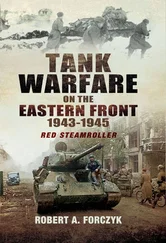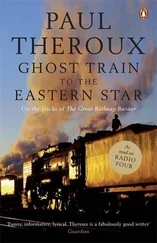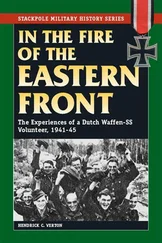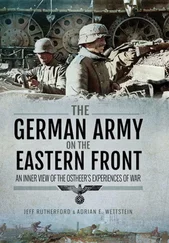Robert A. Forczyk
TANK WARFARE ON THE EASTERN FRONT, 1941–1942
SCHWERPUNKT
A mixed German armoured Kampfgruppe begins the attack into the Soviet Union.
Abandoned Soviet T-26 light tanks from Oborin’s 14th Mechanized Corps in Kobrin, 23 June 1941.
A knocked-out T-26 light tank and a victim of the early border battles.
A Pz.38(t) light tank from the 12.Panzer-Division, which was part of Hoth’s Panzergruppe 3.
A German infantryman approaches a dead Soviet tanker next to his burning BT-7 fast tank, Ukraine, June 1941.
A 15cm sIG 33 (sf), probably from 1.Panzer-Division, passes an abandoned KV-2 heavy tank in June 1941.
During the Battle of Dubno on 26 June 1941, the Soviet 12th Tank Division attempted to attack the German-held village of Leshnev, but advancing into marshy terrain along the Syten’ka River they lost three T-34 tanks that got bogged down.
A T-34 Model 1941 which overran and crushed a German l.FH18 10.5cm howitzer.
A StuG III assault gun crossing a river in the early stages of Operation Barbarossa.
The hull of a KV-1 with at least four medium-caliber anti-tank round hits, which failed to penetrate, but a large-caliber artillery round, either 10.5cm or 15cm, has damaged the track.
A KV-1 heavy tank from the 124th Armored Brigade ambushed a German column northeast of Ivanovka on 9 October 1941.
Soviet tankers examine a Pz.38(t) light tank from the 7.Panzer-Division, abandoned near Yartsevo.
The onset of mud slowed down, but did not stop, German operations.
Soviet T-26 light tanks lead Timoshenko’s counterattacks during the fighting near Smolensk in August 1941.
A Pz.III medium tank from 10.Panzer-Division, knocked out near Skirminova, east of Volokolamsk in mid-November 1941.
The last stage of Operation Typhoon began with German panzers attempting to batter their way through Rokossovsky’s final layer of defense outside Moscow.
A Soviet white-washed T-34 in hull-down position awaits the German panzers, near Volokolamsk, November 1941.
Polkovnik Mikhail G. Sakhno’s tanks from the Moscow Proletarian Motorized Rifle Division move to a new position in the vicinity of Naro-Fominsk, December 1941.
Two overturned Matilda II tanks near Volokolamsk, 1 December 1941.
A T-34 tank moving at speed in deep snow.
The crew of a Pz.III tank from the 14.Panzer-Division watch German infantry clearing a village, mid-1942.
The interior of Hube’s command vehicle, 16.Panzer-Division.
A Pz.III tank from 11.Panzer-Division in action during the opening stages of Operation Blau, 28–30 June 1942.
An 8.8cm flak gun employing direct fire against Soviet armour.
A Pz.IV tank destroyed during the Second Battle of Kharkov in May 1942.
A Pz.III Ausf J with long 5cm gun.
An American-built Lend-Lease M3 Lee tank, shattered by 8.8cm anti-tank fire.
Tiger I heavy tank in August 1942.
A T-34 tank moving over rough terrain with infantry in desant role.
A Pz.IV Ausf G with long 7.5cm cannon in mid-1942.
A KV-1 heavy tank that overran a German reconnaissance car at the Battle of Ostrov.
A German Tauchpanzer III in testing.
Overview – disposition of major German and Soviet armoured units at start of Barbarossa, 22 June 1941 and major battle sites, limit of German advance
Von Schweppenburg’s XXIV Armeekorps (mot.) crosses the Bug River and defeats Oborin’s 14th Mechanized Corps, 22–23 June
Cherniavsky’s 1st Mechanized Corps versus Reinhardt’s XXXXI Armeekorps (mot.); Soviet 3rd Tank Division counterattack against 1.Panzer-Division at Ostrov, 5–6 July and delay back to Pskov, 7–9 July
Panzergruppe 1 executes the Uman encirclement against the Soviet 6th and 12th Armies, 15 July–3 August
Yeremenko’s Deep Battle, 30 August–7 September; Group Ermakov, including 18th Tank Division attacks Lemelsen’s XXXXVII Armeekorps (mot.) in order to ‘smash Panzergruppe Guderian’
Overview – the front line, 28 June 1942. German objectives, major tank battles of 1942 on the Eastern Front
Tank battles west of Voronezh, 28 June–6 July 1942; Hoth’s 4.Panzerarmee versus multiple Soviet tank corps
Tank battles north of Orel, 5–12 July 1942
Hube’s 16.Panzer-Division’s drive to the Volga, 23 August, and Soviet armoured counterattack, 26 August 1942
Kravchenko’s 4th Tank Corps Advance to Kalach, 19–23 November 1942
ABTU – Auto-Bronetankovoe Upravlenie (Main Tank Directorate), 1934–40.
AFV – Armoured Fighting Vehicle.
AOK – Armeeoberkommando (Army).
AP – Armour Piercing.
APBC – Armour Piercing Ballistic Cap.
APHE – Armour Piercing High Explosive.
C 2 – Command and Control.
cbm – cubic meter of fuel, equivalent to 5,000 liters or 739kg.
DD – Dal’noe deistvie (long-range tanks).
DPP – Dal’nia podderzhka pekhotny (Distant infantry support tanks).
Fliegerverbindungsoffizier – Flivo , Luftwaffe liaison officer at Panzerarmee, created May 1942.
GABTU – Glavnoe Avto-Brone-Tankovoe Upravlenie (Chief Department of Autos and Armoured Vehicles), 1940–45.
Gefechtstroß – Combat trains, including ammunition trailers.
Gepäcktroß – Baggage train, including field kitchens.
GKO – Gosudarstvennij Komitet Oboroniy (State Defense Committee).
Großtransportraum – Large transport (GTR).
HEAT – High Explosive Anti-Tank.
HKL – Hauptkampflinie (main line of resistance).
Instandsetzungsgruppe – Repair group.
Kradschützen – Motorcycle infantry.
LSSAH – Leibstandarte SS Adolf Hitler.
MD – Military District.
NKO – Narodnyi Kommisariat Oborony (the People’s Commissariat of Defense).
NKTP – Narodnyi Kommissariat Tankovoy Promyslennosti (the People’s Commissariat of the Tank Industry).
NKVD – Narodnyi Kommisariat Vneshnykh Del (People’s Commissariat of Internal Affairs).
NPP – Neposredstvennaia podderzhka pekhoty (direct infantry support tank).
OKH – Oberkommando des Heeres (German, Army High Command).
OTB – Отдельные танковые батальоны (Independent Tank Battalion).
OTTPP – Otdelniy Tyazhelij Tankovij Polk Proriva (Independent Heavy Tank Breakthrough Regiment).
PP – podderzhka pekhoty (infantry support tanks).
Pz.Regt – Panzer Regiment.
PZAOK – Panzerarmee.
RKKA – Raboche-Krest’yanskaya Krasnaya Armiya (the Army of Workers and Peasants/the Red Army).
RVGK – Rezerv Verkhovnogo Glavnokomandovaniya (Reserve of Supreme High Command).
SAP – Samokhodno-Artillerijskij Polk (Self-Propelled Artillery Regiment).
SR – Schützen-Regiment [Motorized Infantry].
StZ – Stalingrad Tank Factory.
TSAP – Tyazhelij Samokhodno-Artillerijskij Polk (Heavy Self-Propelled Artillery Regiment).
TTPP – Tyazhelij Tankovij Polk Proriva (Heavy Tank Breakthrough Regiment).
UMM – Upravlenie Motorizatzii i Mekhanizatzii RKKA (Directorate of Mechanization and Motorization of the Red Army), 1929–34. Re-named ABTU.
VAMM – Voennaya Akademiya Mekhanizatzii i Motorizatzii RKKA (Military Academy of Mechanization and Motorization of the Red Army).
Читать дальше








![John Stieber - Against the Odds - Survival on the Russian Front 1944-1945 [2nd Edition]](/books/405234/john-stieber-against-the-odds-survival-on-the-russian-front-1944-1945-2nd-edition-thumb.webp)




